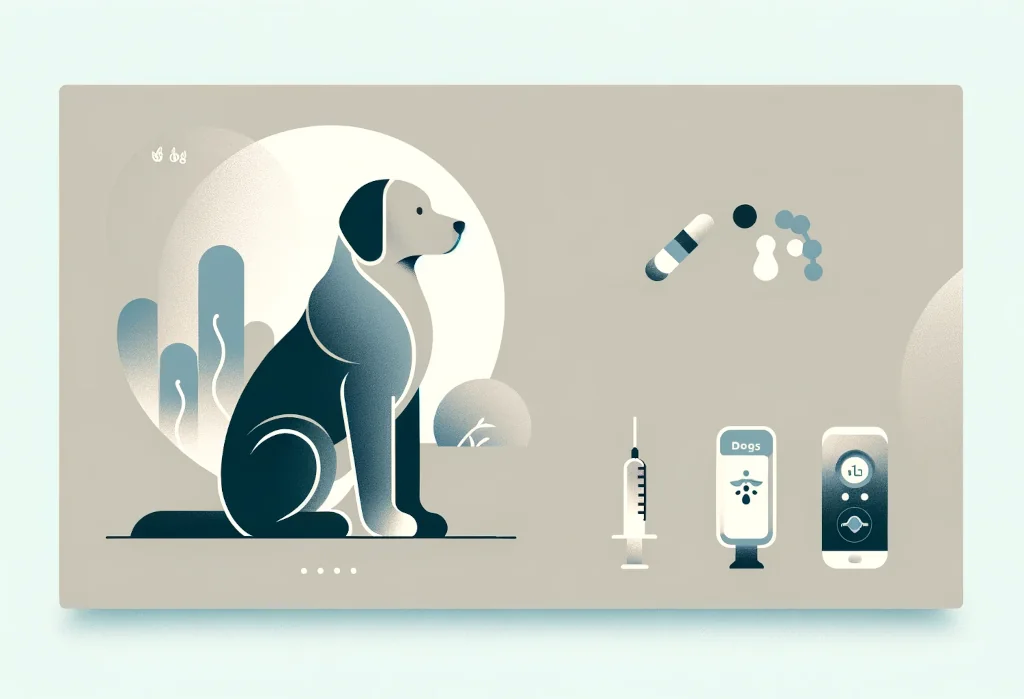When man’s best friend faces the battle against diabetes, we as owners feel the pinch of their struggle. It’s not just about the extra vet visits—it’s managing a condition that can feel overwhelmingly complex.
This blog post will guide you through the essential steps to effectively manage your furry friend’s diabetes.
Key takeaways:
- Regular insulin injections are crucial for managing canine diabetes, and home blood glucose monitoring can provide tight glycemic control.
- A consistent routine with a high-fiber, low-fat diet and regular exercise is key for maintaining steady blood sugar levels in diabetic dogs.
- Keep up with regular vet check-ups to monitor for diabetes-related complications and adjust treatment as necessary.
What Is Diabetes Mellitus in Dogs, and Why Does It Happen?
Diabetes mellitus in dogs is akin to a tightrope walk for their bodies, having to balance blood sugar levels without tipping over. When this balance is lost, you end up with a diabetic pup on your hands. In dogs, diabetes is often a condition where the body struggles to regulate glucose due to insufficient insulin production (type 1 diabetes) or the body’s inability to respond to insulin (type 2 diabetes, though much rarer in dogs).
Several culprits can be blamed for tipping that balance, including genetic predisposition, obesity, and certain medications. Let’s not forget pancreatitis, which can also throw a wrench into the works. Certain breeds are more predisposed to the condition, like Australian Terriers and Standard Schnauzers, but let’s be clear—diabetes doesn’t play favorites and can develop in any breed.
How Can You Recognize Diabetes in Your Dog?
If you notice your furry friend guzzling down water like there’s no tomorrow or making a beeline for the loo more often, it’s time for a head’s up. Here’s a rundown of the red flags:
- Increased thirst and urination: The classics. An unquenchable thirst and frequent bathroom breaks are tell-tale signs.
- Weight loss despite ravenous appetite: Paradoxical, isn’t it? They’re eating like a horse but dropping pounds.
- Lethargy: If your usually sprightly pup seems to have had the wind knocked out of them, pay attention.
- Cloudy eyes: Specifically the onset of cataracts, which can lead to blindness.
- Recurring infections: This one’s a subtle hint. If your pooch keeps getting infections, something could be amiss.
Now, let’s not beat around the bush—if these symptoms are ringing any bells, a vet visit is non-negotiable.
What Are Your Treatment Options for a Diabetic Dog?
Insulin therapy , you guessed it, is the cornerstone of managing canine diabetes. Each dog responds differently, so your vet will be the maestro, conducting the symphony of injections and monitoring to hit the right note.
But let’s not overlook the dynamic duo of diet and exercise. Here are some specifics:
- High-fiber, low-fat diet: Helps manage glucose levels and keeps Rover feeling full.
- Consistent meal and exercise times: Regularity is key to keeping those sugar levels steady.
- Weight management: Keeping your pup trim is half the battle won.
Now for the inside scoop, the often-missed ace up your sleeve: monitoring blood glucose at home. Yup, a bit daunting, but it’s a game-changer for tight glycemic control and catching swings before they spiral. Devices designed for dogs are available, and it’s a powerful tool in your arsenal against diabetes’ curveballs.
Remember, paw-owners, while these steps lay the groundwork, this journey’s a marathon, not a sprint. Don’t sprint to the finish line after this paragraph—you’ve got a whole hind-end of the blog post waiting with more juicy tidbits on managing your dog’s diabetes. Stay tuned, treat your pup’s condition with the respect it deserves, and you’ll both find the stride that works.
How Do You Administer Insulin to Your Dog?
Administering insulin to your furry friend might seem daunting at first, but with a calm approach and steady routine, it can become as natural as their daily walks. Here’s how to ensure it’s done safely:
-
Keep Insulin Chilled: Before anything else, it’s critical to keep the insulin in the fridge. Warm or room temperature insulin can be less effective or even harmful.
-
Wash Your Hands: This is a no-brainer! Clean hands help prevent infection at the injection site.
-
Gently Mix the Insulin: Roll the insulin vial between your hands to mix it, avoiding shaking as it can create air bubbles. This ensures your pup gets the proper dosage.
-
Prep the Syringe: Draw up the insulin carefully. If you spot air bubbles, tap the syringe gently with your finger to let them rise to the top, then push them out.
-
Stay Calm and Distract Your Dog: Dogs can sense stress. Keep it cool and offer some gentle pats or a soothing voice. Some pet parents find giving a treat or a bit of food distracts their pooch nicely during the shot.
-
Pick the Spot: The area on the side of your dog’s abdomen or the scruff of the neck are common injection sites. Rotate these spots to avoid soreness.
-
Administer the Insulin: Lift the skin to form a ‘tent’, insert the needle at a slight angle, and push the plunger smoothly. Make it quick and precise to minimize discomfort.
-
Reward and Praise: After the injection, offer heaps of praise, a cuddle, or a small treat. Positive reinforcement can make the next session easier for both of you.
Remember, never bend or break the needle before disposal and always use a proper sharps container. A UNIQUE tip? Warm the injection spot with a cloth beforehand – it can make the experience less shocking for your doggy pal.
Can Diet and Exercise Make a Difference?
Absolutely! Diet and exercise are twin pillars supporting the management of your dog’s diabetes. Here’s the scoop:
-
Diet: High fiber diets are often recommended for diabetic dogs. They help moderate blood sugar levels after eating. Consider commercially prepared diabetic-friendly dog food or consult with your vet for a tailored eating plan. In addition, refrain from giving treats high in sugar or carbohydrates.
-
Consistency is Key: Always feed your dog at the same time each day to coincide with their insulin injections. Consistent meal times help regulate blood sugar much more effectively.
-
Avoid Obesity: Extra pounds can be detrimental in diabetes management. If your furry friend is on the heavier side, aim for a gradual weight loss by controlling calorie intake.
-
Exercise: Regular, moderate exercise can help control blood sugar levels and keep your dog healthy. However, stick to a routine as too much variation can cause blood sugar spikes.
Like a tailor fine-tuning a suit, adjust diet and exercise based on your vet’s recommendations and your dog’s reactions. After all, every dog is different!
How Do You Monitor Your Dog’s Blood Sugar at Home?
Regular monitoring of your dog’s blood sugar levels is key in managing diabetes, ensuring they stay within a safe range. Here’s how you can be your dog’s home health hero:
First off, you’ll need a reliable glucometer designed for pets (AlphaTRAK is a popular choice). Simply pricking your dog’s ear or paw pad can provide a blood sample to check their sugar levels.
Follow these steps:
- Prep Your Pup: Choose a quiet, comfortable spot and soothe your dog. Maybe play some soft music or engage in a relaxing petting session beforehand.
- Gather Your Gear: Have cotton balls, the glucometer, and test strips at the ready.
- Get the Sample: Prick the edge of the ear or paw pad to get a drop of blood. If using the ear, warming it first can make the blood draw easier.
- Test Away: Apply the blood to the test strip according to the glucometer’s instructions and wait for the magic – a reading of your dog’s current blood glucose level.
- Record the Results: Keep a log of the readings. Trends in these numbers can be incredibly informative for ongoing diabetes management.
Remember, while home testing is a fantastic way to keep tabs on your dog’s health, it’s not a replacement for regular vet check-ups. Regular professional evaluation is crucial in fine-tuning diabetes treatment.
Incorporate these practices and you’ll be well on your way to managing your dog’s diabetes with confidence and care. Keep it up, and don’t forget: a little love goes a long way in helping your four-legged friend feel their best!
Long-Term Considerations for Diabetic Dogs
Living with a diabetic dog is a journey of care and attention to detail. Over time, certain health complications can rear their heads, but with the right know-how, these can often be managed effectively. Let’s paw through some of these potential issues and dig up some strategies to keep them at bay.
Eye Care: Preventing Blindness
Cataracts are a frequent complication in diabetic dogs, often leading to blindness if not managed appropriately. Here’s a snippet of wisdom: Regular check-ups with a veterinary ophthalmologist can catch eye issues before they escalate. Additionally, maintaining stable blood sugar levels is key in slowing cataract development. Some pups might even be candidates for cataract surgery, which can significantly improve their quality of life.
Weight Control: Striking the Right Balance
Keeping your dog at a healthy weight is crucial. Too much poundage can exacerbate their diabetes, while being underweight is a sign that their diabetes may not be under control. Feed them a diet recommended by your vet and stick to regular feeding and exercise routines. Remember the adage: An ounce of prevention is worth a pound of cure!
Dental Health: More Than Just a Pretty Smile
Did you know that poor dental health can affect blood sugar control? Regular dental check-ups and cleanings are a must. At home, engage in daily tooth brushing or give your dog dental chews approved by your vet. A clean mouth can lead to a more stable diabetic status.
Regular Blood Sugar Monitoring
Monitoring your dog’s blood sugar can be a real balancing act. It’s like walking a tightrope – too much or too little sugar, and you risk a fall. You’ll need to work closely with your vet to determine the best monitoring routine, which may include home glucose testing or periodic vet visits.
The Unique Tip: Cognitive Function and Enrichment
Here’s a bone of wisdom most don’t dig up: Diabetes can impact a dog’s cognitive function over time. Mental exercises and enrichment activities are not only fun but could also help keep their mind sharp. Challenge their brain with new tricks, puzzles, or interactive toys. This engagement could make a world of difference in slowing cognitive decline.
Infection Watch: Staying Vigilant
Diabetic dogs have a higher risk for infections, so it’s important to stay on top of things. Whether it’s a urinary tract infection or skin issues, early detection and treatment are the name of the game.
Supportive Supplements
Some supplements, such as antioxidants and Omega-3 fatty acids, could be beneficial for diabetic dogs – but always consult your vet first. They can help you navigate the sea of options and find what’s best for your furry friend.
Consistency Is Key
A consistent routine is the golden thread weaving through the fabric of diabetic dog care. Regular feeding times, consistent exercise, and a stable medication schedule help to avoid blood sugar spikes and dips.
The Big Picture
It’s not just about managing diabetes — it’s about ensuring your dog lives a happy, fulfilling life. Focusing on a holistic approach that encompasses diet, exercise, regular vet visits, and plenty of love and attention can make all the difference.
Remember, while the road might be a bit rocky, every step you take to manage your dog’s diabetes is a step towards more tail wags and happy, healthy years together. Keep these considerations in mind, and with a bit of luck and a lot of love, you and your pooch will navigate the twists and turns of diabetes with confidence and grace. ?
Alex, a passionate animal lover, has experience in training and understanding animal behavior. As a proud pet parent to two dogs and three cats, he founded AnimalReport.net to share insights from animal experts and expand his knowledge of the animal kingdom.





